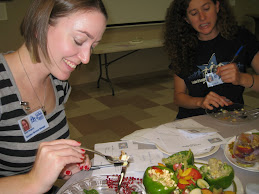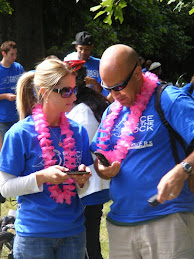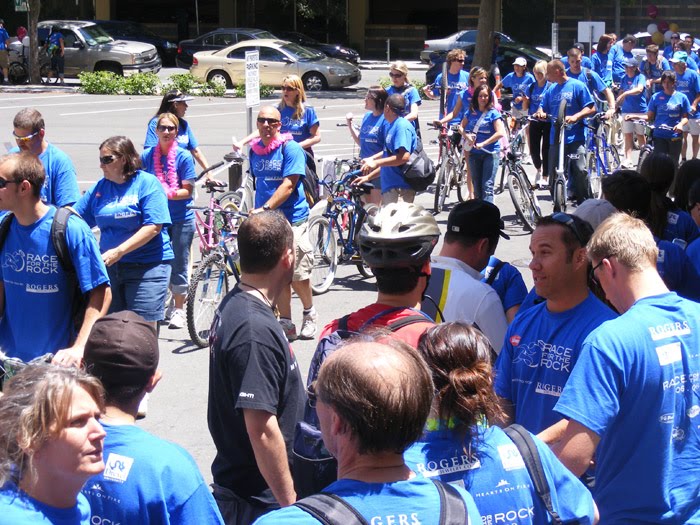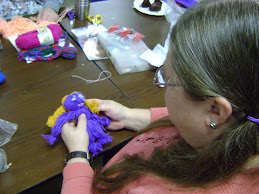 It’s
a chilly February morning. The ground is still glistening from last night’s rain.
As I drive towards my destination, my mind wonders about what I might see
there. I am on my way to North Metro Church of Christ, one of ten food distribution
sites of Sacramento Food Bank and Family Services (SFBFS). I’ve never been to a
food distribution, but I imagine a long line of people waiting behind a large
box truck for a handout of cheese blocks and dried beans.
It’s
a chilly February morning. The ground is still glistening from last night’s rain.
As I drive towards my destination, my mind wonders about what I might see
there. I am on my way to North Metro Church of Christ, one of ten food distribution
sites of Sacramento Food Bank and Family Services (SFBFS). I’ve never been to a
food distribution, but I imagine a long line of people waiting behind a large
box truck for a handout of cheese blocks and dried beans. Having already passed it once, I arrive at the church. It is set back from the road on a large plot of land surrounded by a chain link fence. I pull my car through a narrow gate and head to the parking lot on the right. All of the parking spaces are full. I dead end into a line of people so long they flow out a side entrance of the church parking lot. I check the clock. It is only 10:30 am. The distribution doesn’t start until 11:00 am. A man wearing a small tank of oxygen, like a necklace around his neck, is walking away from the line. Carefully, I back my car up, turn around, and drive around to the other side of the church looking for a place to park. This side isn’t quite so full. I pull into a space, hop out of my car, grab a sweatshirt, and make my way to the back lot of the church not sure I’m prepared for what I am about to see.
As I approach, my ears are greeted with the sounds of Stevie Wonder singing “Higher Ground.” I turn the corner to find a bustling of activity. Children are jumping in puddles, several volunteers are sorting through bins of food, and booths are being neatly arranged under blue tent canopies. There are about one hundred or so people hanging out in white folding chairs in front of the booths. It looks like a small community fair, not at all like the cold, impersonal event I had imagined. There are box trucks, but they are being unloaded and the food set out on tables, much like a farmer’s market.
With the help of a volunteer, I find the Food Program Director, Erik Kintzel, who shows me around the distribution site. Erik tells me that they will serve around 175 households on this particular day, close to 500 people. Each household will be given roughly 30 pounds of food: five pounds of chicken, a bag of potatoes, two bags of canned food, pears, apples, oranges, chard, bread, and much more. Under the food distribution tables are boxes labeled Capay Organic Farms. Some of the food provided is donated by individuals, some purchased at discounted rates by SFBFS, but much of the produce comes from local organic farms.

We make our way towards the long line in front while Erik explains the registration process. “This is the only time clients will stand in line,” he tells me. “After they go through registration, they can sit down.” He points to the folding chairs located behind registration. Many have already gone through the registration process and are sitting comfortably in the chairs. Some of the clients are older and wouldn’t do well standing in yet another line waiting for food. Pointing to the registration line Erik says, “That breaks my heart. I wish we could eliminate the need for that line, but for now…” He goes on to explain that food used to be distributed through a window at the SFBFS location in Oak Park. People would stand in long lines outside, and make their through a cold hallway, until they reached a window where someone would hand them food. A lot of care and effort has gone into moving away from that cold and impersonal format to a more dignified and friendly approach.
We continue the tour, and I am drawn to a table lined with colorful baskets and orange laminated cards. In the baskets are examples of the different types of fruits and vegetables people will receive; fresh chard, acorn squash, and butternut squash are just a few of the items displayed. The laminated orange placards identify the fruit or vegetable, give the health benefits, ways to prepare, and information on how to store the item. Handouts with recipes for some of the items can be found on the next table. People aren’t just given food; they are equipped with recipes and preparation techniques to empower them to use the foods they are given.
It is just about time for the distribution to begin, and volunteers huddle for a few motivational words from Erik. There are about forty volunteers today; thirty-three of them are sixth graders from s local elementary school. Erik encourages the kids to hand out a fruit or vegetable that they like and stay away from the ones they don’t. He wants them to be proud of what they are doing, to smile, and to interact with those to whom they are handing out food. He also tells them to have fun. After speaking to the volunteers, Erik heads to the microphone to address the clients. He asks them enthusiastically if they are ready to begin. Again, it feels more like a fun family event than an emergency food distribution.

It’s time to begin, but rather than lining up, clients are called by number. After hearing their number, clients check in and head over to gather their food. It is obvious that some have received food before. They come prepared with rolling basket carts. Others are less prepared, seemingly overwhelmed by the amount of food they are about to receive. With or without a basket, most show up with a smile. Number after number is called and people come to claim their food. Music plays the entire time and some of the clients dance their way to pick up their items. An older client, wearing a USAF cap, jokingly repeats the numbers and invites people to, “Come on down!” Price is Right style. When his number is called, he cries one last time, “Come on down!” then makes his way, gathering his items, shaking the hand of each volunteer and thanking them with a warm and sincere smile.
We’re now more than an hour into the food distribution, and a Michael Jackson song plays. Two of the sixth grade boys moon-walk their way to hand out food and sing along with loud bursts of, “Hee, hee.” These kids are clearly having fun. With less than an hour left of the scheduled distribution time, the line for registration has dwindled down to around a handful of people. The crowd waiting in the folding chairs is still quite large, although they’ve already made their way to number 104. I think Erik may have slightly underestimated the expected turn out today.
With that unfriendly image of a World War II style food rationing erased from my mind, I make my way back to my car. Three of the sixth grade boys have just helped a woman carry her food to her car and are racing to be the first to get back to their volunteer duties. I smile at their enthusiasm as I get into my car and head home, hungry and grateful for the pantry full of food that awaits me.
The author returned as a volunteer shortly after attending her first distribution as an observer.






No comments:
Post a Comment